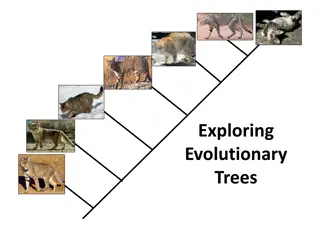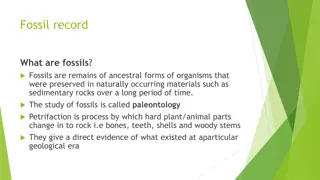Exploring Human Origins Through Hominid Fossils and Evolutionary Traits
Delve into the fascinating world of human origins, examining hominid fossils, anatomical traits, and evolutionary evidence. Learn about early species like Ardipithecus ramidus, differentiate African apes from modern humans, and analyze the genetic lineage supporting human evolution. Explore tables, graphs, and discussions on the Out of Africa theory, all shedding light on our evolutionary journey.
Download Presentation

Please find below an Image/Link to download the presentation.
The content on the website is provided AS IS for your information and personal use only. It may not be sold, licensed, or shared on other websites without obtaining consent from the author. Download presentation by click this link. If you encounter any issues during the download, it is possible that the publisher has removed the file from their server.
E N D
Presentation Transcript
ASSET TUTORING REVISION HUMAN ORIGINS Q & A
Section A 1. Which of the feet shown below belong to Homo sapiens? 2. Early fossils of Ardipithecus ramidus were first found in: A. Kenya B. South Africa C. Ethiopia D. Tanzania
Section B Q 3.1 table analysis Study the table below, which indicates some of the hominid fossils found in the world and answer the questions that follow. Read the text, hominid fossils and then spend some time analyzing the table, understand mya = millions of years ago. Some of the ancestors are not on CAPS, it does not matter. 3.1 Read carefully
Q 3.1 continued Q 3.1.2 = explain and Out of Africa (you are not being asked what the Out of Africa hypothesis but keep it mind). 3.1.3 = genetic line of evidence go to the Human Origins PPT1 & 2 3.1.4 only refer to the table. 3.1.5 from PPT2
Alternative Q 3.1 This q includes multiple skills eg table analysis, calculation, graph drawing (DBE Nov 2017) Read the text and analyse the table, what is the main theme of this question? Do you know primates, extinct, fossils, evidence, hominids? 3.1.1 from your knowledge 3.1.2 read off the table 3.1.3 think of the inside of the skull where the brain is found
Alternative Q 3.1 continued 3.1.4 Calculation, living primates show all steps. 3.1.5 Only from the table give units as well as numbers. 3.1.6 Draw a bar graph, only Homo species of which there are 4 see next page for bar graphs
Drawing bar graphs 1 In this case you already have the table in the Question paper.
Drawing bar graphs 2
Q 3.2 state, differentiate African apes and modern humans belong to the order Primates. Answer the questions below regarding the anatomical similarities and differences. 3.2.1 State ONE similarity between the hands of African apes and modern humans. 3.2.2 Differentiate between the palate shape & dentition of African apes and modern humans. [5] Read the text then all the questions before answering. 3.2.1 State a similarity between the hands only. 3.2.2 Differentiate = state the differences, with reference to the palate shape & dentition. Imagine the picture of the underside of the palate and the teeth see PPT1 NB you are NOT being asked to tabulate the differences. (1) (4)
Section B Q 3.5 Read the passage below and answer the questions that follow. Read the text really carefully. What is the theme of the text? Do you know the key words: fossils, traits, genus, transitional fossil and bipedal? Go to next slide for questions
Question 3.5 on the Hominin article NB ALWAYS LOOK AT NUMBER OF MARKS 3.5.1 Go back to the extract and look for the text being referred to and underline it, then answer the question. 3.5.2 Must give 5 pieces of evidence from the text/extract 3.5.3 EXPLAIN = cause & effect or statement & reason. TWO ONLY 3.5.4 Explain again. Refer to teeth/dentition and to the text
Section C Essays can be asked on Human Origins Read the text that introduces the question then read and analyse the question. What is the theme? Divide the question into paragraphs see next slide
1. State the 'Out of Africa' hypothesis. Probably 3 marks 2. Describe the evidence that supports the 'Out of Africa' hypothesis and (refer to Exam guidelines and PPT 1 & 2), even though cultural evidence is not listed in the exam guidelines, give it as well. (8 marks) 3. (describe) the evidence that shows that the three primate genera mentioned above, were all bipedal. (Refer to Exam guidelines and PPT 1 & 2) (6 marks)























